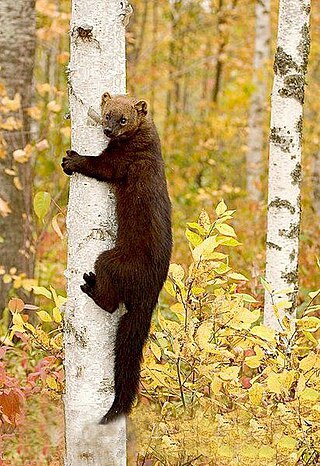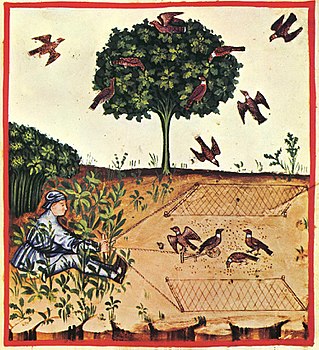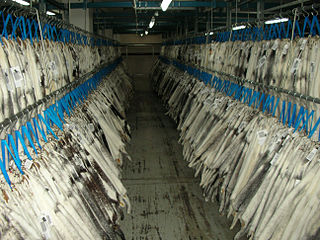
Mink are dark-colored, semiaquatic, carnivorous mammals of the genera Neogale and Mustela and part of the family Mustelidae, which also includes weasels, otters, and ferrets. There are two extant species referred to as "mink": the American mink and the European mink. The extinct sea mink was related to the American mink but was much larger.

Fur farming is the practice of breeding or raising certain types of animals for their fur.

The fur trade is a worldwide industry dealing in the acquisition and sale of animal fur. Since the establishment of a world fur market in the early modern period, furs of boreal, polar and cold temperate mammalian animals have been the most valued. Historically the trade stimulated the exploration and colonization of Siberia, northern North America, and the South Shetland and South Sandwich Islands.

The fisher is a carnivorous mammal native to North America, a forest-dwelling creature whose range covers much of the boreal forest in Canada to the northern United States. It is a member of the mustelid family, and is the only living member of the genus Pekania. It is sometimes referred to as a fisher cat, although it is not a cat.

The American mink is a semiaquatic species of mustelid native to North America, though human introduction has expanded its range to many parts of Europe, Asia, and South America. Because of range expansion, the American mink is classed as a least-concern species by the IUCN. The American mink was formerly thought to be the only extant member of the genus Neovison following the extinction of the sea mink (N. macrodon), but recent studies, followed by taxonomic authorities, have reclassified it and the sea mink within the genus Neogale, which also contains a few New World weasel species. The American mink is a carnivore that feeds on rodents, fish, crustaceans, frogs, and birds. In its introduced range in Europe it has been classified as an invasive species linked to declines in European mink, Pyrenean desman, and water vole populations. It is the animal most frequently farmed for its fur, exceeding the silver fox, sable, marten, and skunk in economic importance.

Fur clothing is clothing made from the preserved skins of mammals. Fur is one of the oldest forms of clothing and is thought to have been widely used by people for at least 120,000 years. The term 'fur' is often used to refer to a specific item of clothing such as a coat, wrap, or shawl made from the fur of animals.

The striped skunk is a skunk of the genus Mephitis that occurs across much of North America, including southern Canada, the United States, and northern Mexico. It is currently listed as least concern by the IUCN on account of its wide range and ability to adapt to human-modified environments.

Animal trapping, or simply trapping or ginning, is the use of a device to remotely catch and often kill an animal. Animals may be trapped for a variety of purposes, including for meat, fur, sport hunting, pest control, and wildlife management.
This timeline of Animal Liberation Front (ALF) actions describes the history, consequences and theory of direct action on behalf of animals by animal liberation activists using, or associated with the ALF.

Peter Daniel Young is an American animal rights activist. He was indicted by a federal grand jury in 1998 on charges related to fur farm raids in Iowa, South Dakota, and Wisconsin in 1997. He was in hiding for seven years, before being arrested in San Jose and sentenced to two years' imprisonment in 2005. Young was released in February 2007.
The American Legend Cooperative (ALC) was an agricultural marketing cooperative of mink fur farmers in the United States and Canada, best known for its Blackglama, American Legend brands of fur, as well as the older LEGEND brand. American Legend was formed in 1986 as a merger of the Great Lakes Mink Association (GLMA) and the Mutation Mink Breeders Association (EMBA). It was acquired by North American Fur Auctions in 2018.
The Fur Institute of Canada (FIC) works to promote the fur trade and to advocate for the fur industry. The organization, has more than 100 members from industry and trade, government, Aboriginal groups and the scientific community.

The silver fox, sometimes referred to as the black fox, or blue fox, is a melanistic form of the red fox. Silver foxes display a great deal of pelt variation. Some are completely glossy black except for a white colouration on the tip of the tail, giving them a somewhat silvery appearance. Some silver foxes are bluish-grey, and some may have a cinereous colour on the sides.

Shaw Media, Inc. was the television broadcasting division of Shaw Communications. It owned the Global Television Network, which broadcasts nationally via 13 television stations, as well as 19 specialty channels including Slice, HGTV Canada, Showcase, Food Network Canada, and History. Shaw Media consisted of the broadcasting assets of the former Canwest. Shaw Media properties were acquired in April 2016 by sister company Corus Entertainment.
The Siberian fur trade is an exchange concerned with the gathering, buying and selling of valuable animal furs that originate from Siberia. The Siberian fur trade expanded from localized trade, and Siberian fur is now traded around the world. The Siberian fur trade had a significant impact on the development of Siberia through exploration and colonization. The fur trade also precipitated a decline in the number of fur-bearing animals and resulted in Siberia being conquered by Russia.
Platige Image S.A. is a Polish-based company specializing in the creation of computer graphics, 3D animation, and digital special effects for various fields, including advertising, film, art, education, and entertainment. The studio employs a team of over 320 artists, comprising directors, art directors, graphic designers, and producers. The company has won approximately 280 awards and honors. Its animated shorts have garnered top prizes at SIGGRAPH four times and earned two British Academy of Film and Television Arts (BAFTA) awards. Additionally, the studio has been nominated for the Palme d'Or at the Cannes Film Festival and the Golden Lions at the Venice Film Festival, as well as receiving an Oscar nomination.

The mink industry in Denmark produced 40 percent of the world's pelts. Denmark used to be the largest producer of mink skins in the world. Ranked third in Denmark's agricultural export items of animal origin, fur and mink skins have a yearly export value of about €500 million. Kopenhagen Fur, located in Copenhagen, is the world's largest fur auction house; annually, it sells approximately 14 million Danish mink skins produced by 2,000 Danish fur farmers, and 7 million mink skins produced in other countries. Mink produced in Denmark was considered to be the finest in the world and is ranked by grade, with the best being Saga Royal, followed by Saga, Quality 1, and Quality 2.

Kopenhagen Fur is the largest fur skin auction company in the world. It is an agribusiness cooperative, located in Langagervej 60, Glostrup, near Copenhagen, Denmark. At peak demand, the company is able to pack and sort 150,000 furs in one day. In 2020, it was reported to be responsible for 40% of global mink fur production.

Fur farming is the process of breeding animals in captivity for the sake of harvesting their fur to be sold primarily for clothing purposes. Fur is no longer primarily obtained through animal trapping; most fur comes from farms, where animals are raised to be killed for their fur. Fur farming operations provide about 80 percent of overall fur production. Common sources of fur include mink, raccoon, and fox. Up to 30 million mink furs are produced annually in North America and Europe. The production of pelts involves large-scale tanning and disposal of animal carcasses after they are skinned. Fur production reportedly impacts the environment negatively through the release of gases, chemicals and fossil fuels.













